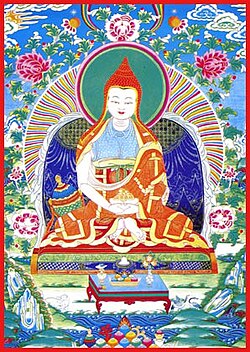
Back মান-ঙ্গাগ-স্দেই-র্গ্যুদ-ব্চু-ব্দুন Bengali/Bangla Escrituras de Dzogchen Spanish Seitseteist tantrat Estonian De 17 tantraer av den store perfeksjon NB

The Seventeen Tantras of the Esoteric Instruction Series (Tibetan: མན་ངག་སྡེའི་རྒྱུད་བཅུ་བདུན, Wylie: man ngag sde'i rgyud bcu bdun) or the Seventeen Tantras of the Ancients (rnying-ma'i rgyud bcu-bdun) are an important collection of tantras in the Nyingma school of Tibetan Buddhism.[1][2] They comprise the core scriptures of the "esoteric instruction series" (Menngagde) of Dzogchen teachings and are its most authoritative scriptures.[1][2]
The Seventeen Tantras are part of the Vima Nyingthig ("Inner Essence of Vimalamitra"), a terma cycle of Dzogchen texts revealed by the treasure discoverer Zhangton Tashi Dorje (c. 1097-1127) and associated with the 8th century Indian monk Vimalamitra who is traditionally believed by the Nyingma school to have first brought these texts to Tibet.[3]
The Vima Nyingthig itself consists of 'tantras' (rgyud), 'agamas' (lung), and 'upadeshas' (man ngag). The other texts are mainly exegetical literature on the material found in the Seventeen tantras.[4] The Seventeen Tantras explain the view (lta ba) of Dzogchen, the two main forms of Dzogchen meditation (sgom pa) - kadag trekchö ("the cutting through of primordial purity"), and lhündrub tögal ("the direct crossing of spontaneous presence") - and the conduct (spyod pa) of a Dzogchen practitioner, along with other ancillary topics.[5][6]
- ^ a b Cuevas (2005), p. 61-62.
- ^ a b Germano (1994), pp. 302–303.
- ^ Hatchell (2014), p. 53-54.
- ^ Germano (1994), p. 269.
- ^ Tweed & Manell (2018), p. xvi.
- ^ Schmidt (2002), p. 38.